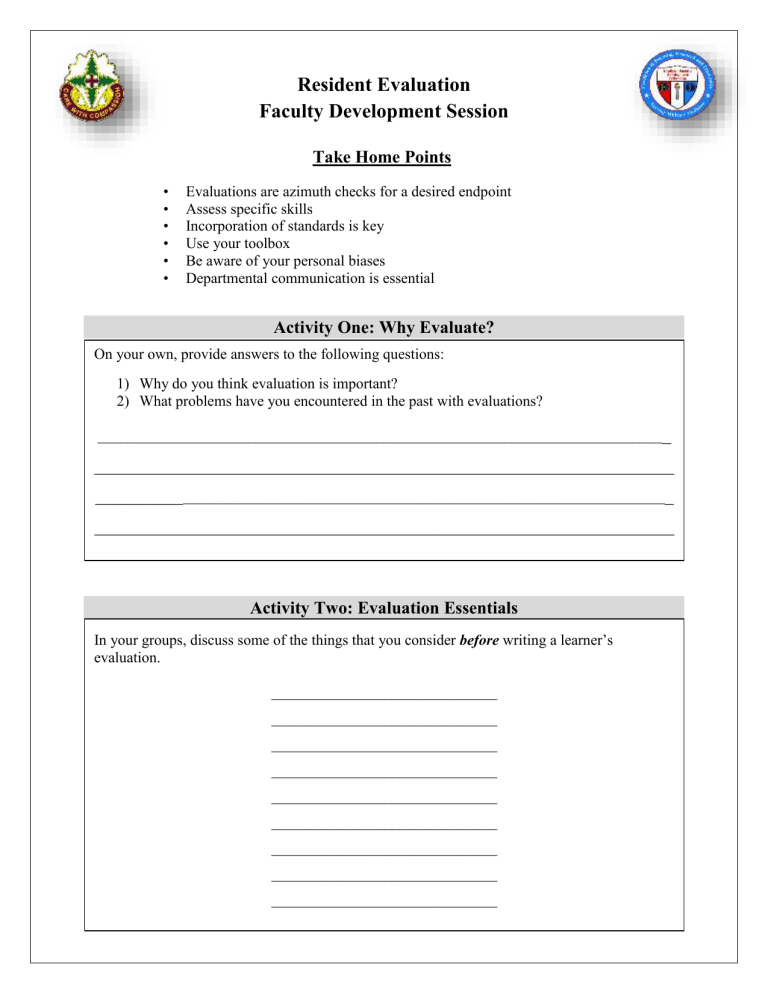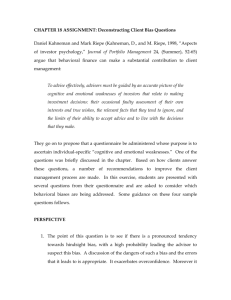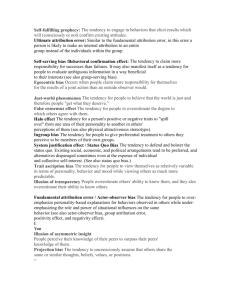Activity One: Why Evaluate?

Resident Evaluation
Faculty Development Session
Take Home Points
•
Evaluations are azimuth checks for a desired endpoint
• Assess specific skills
•
Incorporation of standards is key
•
Use your toolbox
• Be aware of your personal biases
•
Departmental communication is essential
Activity One: Why Evaluate?
On your own, provide answers to the following questions:
1) Why do you think evaluation is important?
2) What problems have you encountered in the past with evaluations?
___________________________________________________________________________ _
__________________________________________________________________
__________ ________________________________________________________________ _
__________________________________________________________________
__________________________________________________________________
Activity Two: Evaluation Essentials
In your groups, discuss some of the things that you consider before writing a learner’s evaluation.
______________________________
______________________________
______________________________
______________________________
______________________________
______________________________
______________________________
______________________________
______________________________
Activity Three: Our Learner’s Skills
In your groups, discuss the skill sets and put them in a ranked order from highest to lowest in importance.
Time Management Procedural Skills
Interpersonal Skills and
Communication
Medical Knowledge
Base
Professionalism History Taking
Decision Making Oral Presentations Compassion
Documentation Patient Advocacy Leadership
Activity Four: Sharpen the Tool
In your groups, review the evaluation tools. How would you improve your tool?
______________________________
______________________________
______________________________
______________________________
______________________________
______________________________
______________________________
______________________________
______________________________
Activity Five: Evaluation Error and Bias
In groups, match the error or bias type with the appropriate description.
___ Recent Incident Bias
___ Central Tendency
___ Extreme Response Bias
C. The opposite of central tendency bias.
Respondents tend to mark extremes rather than those in between. It is difficult to know honest ratings from the halo effect
___ Affirmation/Yea-Saying Bias
D. A potential for negative bias against a trainee because of an isolated recent
___ Incompetence Bias
___ Leniency Bias
___ Halo Effect
___ Contrast Bias
___ Stringency Bias
negative incident or statement, which does not necessarily reflect the usual work ethic of that person
E. Being overly charitable
F. Occurs when evaluators assign high ratings because of lack of confidence or competence
G. The tendency to give positive responses irrespective of their context, also known as inflation of ratings
H. A rater's overall impression of a person will affect his or her rating on each item
I. Rating against another person's performance rather than a standard
A. Being overly critical
B. Sitting on the fence of avoiding the extreme anchors on a scale for fear of being too strong







